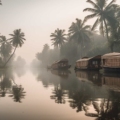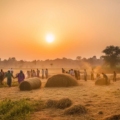Chopta, a name that resonates with serenity and untouched beauty, is a hidden gem nestled in the heart of the Garhwal region in Uttarakhand, India. It stands as a testament to nature’s grandeur, offering a haven for nature enthusiasts and adventure seekers alike.
I. Introduction
A. Definition of Chopta
Chopta, often referred to as the “Mini Switzerland of India,” is a picturesque hill station located at an elevation of 2,680 meters above sea level. This pristine destination remains largely unexplored, contributing to its untouched allure.
B. The allure of hidden paradises
In a world dominated by bustling cities and crowded tourist spots, the charm of hidden paradises like Chopta lies in their ability to offer an escape into the lap of nature, away from the chaos of urban life.
II. Chopta’s Natural Beauty
A. Overview of Chopta’s landscape
Chopta boasts a diverse landscape that includes lush meadows, dense forests, and awe-inspiring mountain views. The region is adorned with vibrant rhododendron blooms during the spring, creating a mesmerizing spectacle.
B. Flora and fauna
The rich biodiversity of Chopta is a treat for nature lovers. From rare orchids to elusive Himalayan wildlife, the region harbors a unique array of flora and fauna, making it a hotspot for biodiversity enthusiasts.
C. Unique ecosystems
Chopta is home to unique ecosystems, including alpine meadows and coniferous forests. These ecosystems contribute to the overall ecological balance of the region, making it a critical area for conservation efforts.
III. Trekking Trails in Chopta
A. Tungnath Temple trek
One of the prominent attractions in Chopta is the Tungnath Temple, the highest Shiva temple in the world. The trek to Tungnath offers not only a spiritual journey but also breathtaking views of the surrounding Himalayan peaks.
B. Chandrashila trek
For the more adventurous souls, the Chandrashila trek is a must-try. The summit provides a panoramic view of the Himalayas, making the arduous journey worthwhile.
C. Deoria Tal trek
Nestled amidst lush greenery, Deoria Tal is a pristine lake accessible through a trek. The reflections of Chaukhamba peaks in the crystal-clear waters create a postcard-worthy scene.
IV. Bird Watching Opportunities
A. Diverse bird species
Chopta is a haven for bird enthusiasts, with a diverse range of avian species. From vibrant Himalayan monals to elusive eagles, the region offers ample opportunities for bird watching.
B. Ideal spots for bird enthusiasts
Certain spots, such as the meadows surrounding Tungnath, serve as ideal locations for bird watching. Binoculars in hand, visitors can marvel at the variety of winged creatures that call Chopta home.
V. Chopta’s Wildlife
A. Notable wildlife species
Chopta is home to various wildlife species, including the Himalayan tahr and musk deer. Conservation efforts are underway to protect these animals and their habitats.
B. Conservation efforts
Local initiatives focus on preserving Chopta’s wildlife. Responsible tourism practices play a crucial role in maintaining the delicate balance between human exploration and wildlife conservation.
VI. Accommodation Options
A. Hotels and resorts
Chopta offers a range of accommodation options, from comfortable hotels to resorts that blend seamlessly with the natural surroundings.
B. Camping experiences
For those seeking a closer connection with nature, camping in Chopta is an unparalleled experience. Under the starlit sky, the tranquility of the surroundings becomes truly immersive.
C. Homestays
To experience the local culture firsthand, homestays are a popular choice. Visitors can engage with the warm hospitality of the locals while enjoying the simplicity of rural life.
VII. Local Cuisine
A. Traditional Garhwali dishes
Chopta introduces visitors to the flavors of Garhwali cuisine, with dishes like Aloo Ke Gutke and Kafuli offering a delightful culinary journey.
B. Unique flavors of Chopta
Local ingredients and traditional cooking methods contribute to the unique flavors of Chopta’s cuisine. Exploring local eateries is a must for food enthusiasts.
VIII. Chopta’s Cultural Heritage
A. Ancient temples
Apart from the spiritual significance of Tungnath, Chopta is home to other ancient temples that showcase the rich cultural heritage of the region.
B. Local festivals and traditions
Visitors may have the opportunity to witness and participate in local festivals, providing a glimpse into the vibrant traditions of the Garhwal region.
IX. Best Time to Visit Chopta
A. Seasonal variations
Chopta experiences distinct seasons, each offering a unique charm. While spring brings vibrant blooms, winter blankets the region in snow, creating a winter wonderland.
B. Weather considerations
Understanding the weather patterns is crucial for a comfortable and enjoyable visit. Clear skies during certain months provide optimal visibility for trekking and photography.
X. Tips for Exploring Chopta
A. Packing essentials
From sturdy trekking shoes to warm clothing, packing essentials ensure a comfortable and safe exploration of Chopta’s terrain.
B. Safety precautions
While Chopta is a paradise for nature lovers, adhering to safety guidelines is imperative. Proper preparation and guidance minimize risks during treks and outdoor activities.
C. Responsible tourism practices
To preserve Chopta’s pristine beauty, visitors are encouraged to adopt responsible tourism practices, including waste management and respecting local customs.
XI. Photography in Chopta
A. Capturing the beauty
Photographers are in for a treat in Chopta, with every frame presenting an opportunity to capture the unspoiled beauty of the landscape.
B. Photography hotspots
Key locations, such as Chandrashila and Deoria Tal, serve as photography hotspots, providing stunning backdrops for nature photography enthusiasts.
XII. Chopta’s Rising Popularity
A. Increased tourism
As the word spreads about Chopta’s beauty, there is a noticeable increase in tourism. Balancing this surge with conservation efforts is essential for the long-term preservation of the region.
B. Balancing conservation and tourism
Local authorities and environmentalists are working together to strike a balance between promoting tourism and ensuring the ecological sustainability of Chopta.
XIII. Personal Experiences
A. Travel stories
Enthusiastic travelers share their personal experiences, recounting the magical moments and challenges they encountered in Chopta.
B. Testimonials
Testimonials from visitors highlight the warmth of the local community, the thrill of trekking, and the overall enchantment of Chopta.
XIV. Conclusion
A. Recap of Chopta’s charm
Chopta, with its untouched beauty, diverse landscapes, and cultural richness, stands as a testament to the marvels of nature.
B. Encouragement to explore
The hidden paradise of Chopta awaits those seeking an escape into nature. Encouraging readers to embark on this journey fosters a sense of curiosity and adventure.
XV. FAQs
A. What makes Chopta a hidden paradise?
Chopta’s untouched landscapes, diverse ecosystems, and cultural richness contribute to its status as a hidden paradise.
B. Are there any challenging trekking trails?
Yes, Chopta offers challenging trekking trails, including the Chandrashila trek, which rewards adventurers with breathtaking views.
C. How can I contribute to wildlife conservation in Chopta?
Visitors can contribute by supporting local conservation initiatives, practicing responsible tourism, and respecting wildlife habitats.
D. Are there any guided tours available?
Yes, several guided tours are available, providing insights into Chopta’s natural beauty and cultural heritage.
E. What should I keep in mind while visiting Chopta?
Visitors should pack essentials, adhere to safety precautions, and practice responsible tourism to ensure a fulfilling and sustainable experience.


